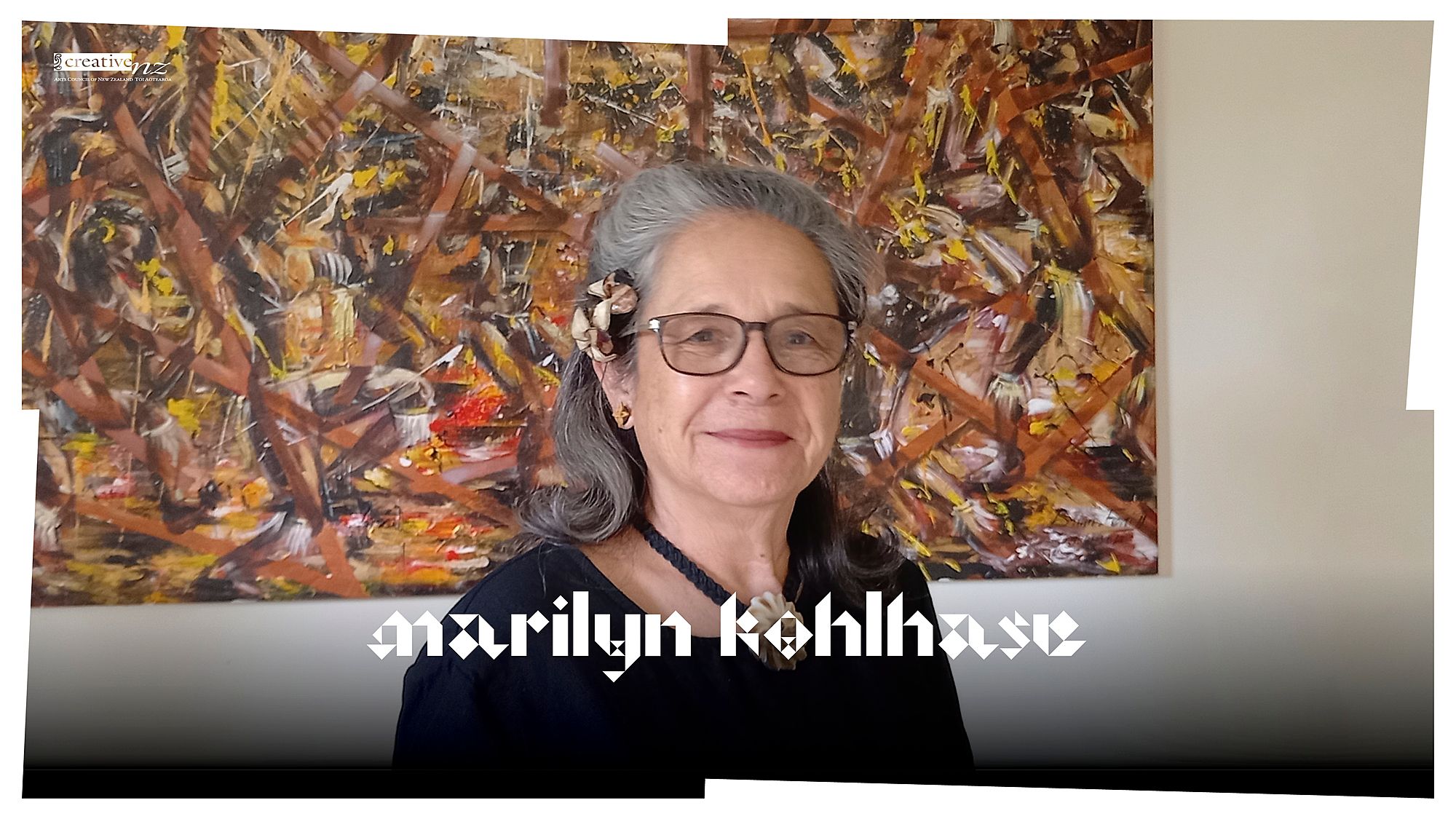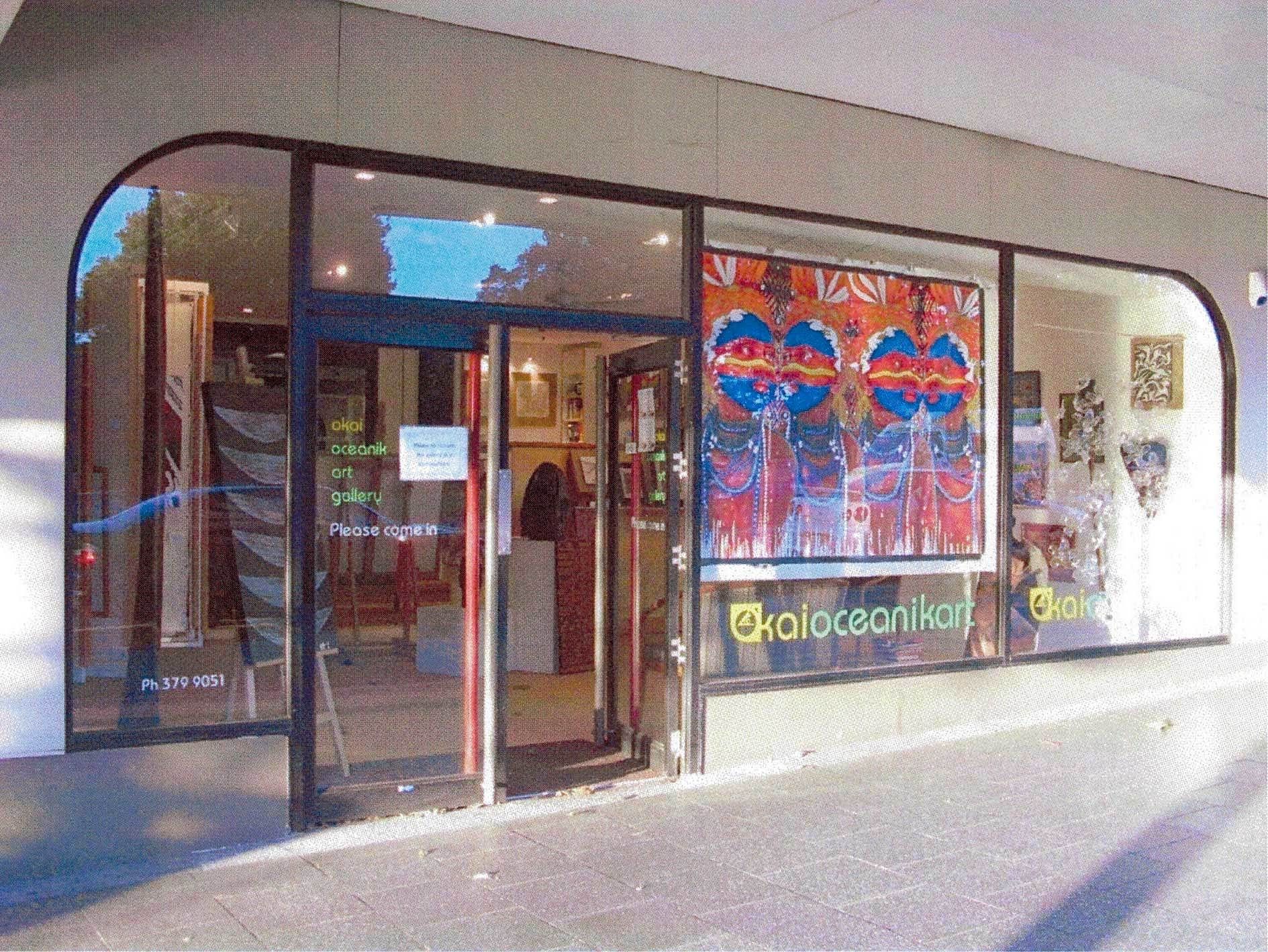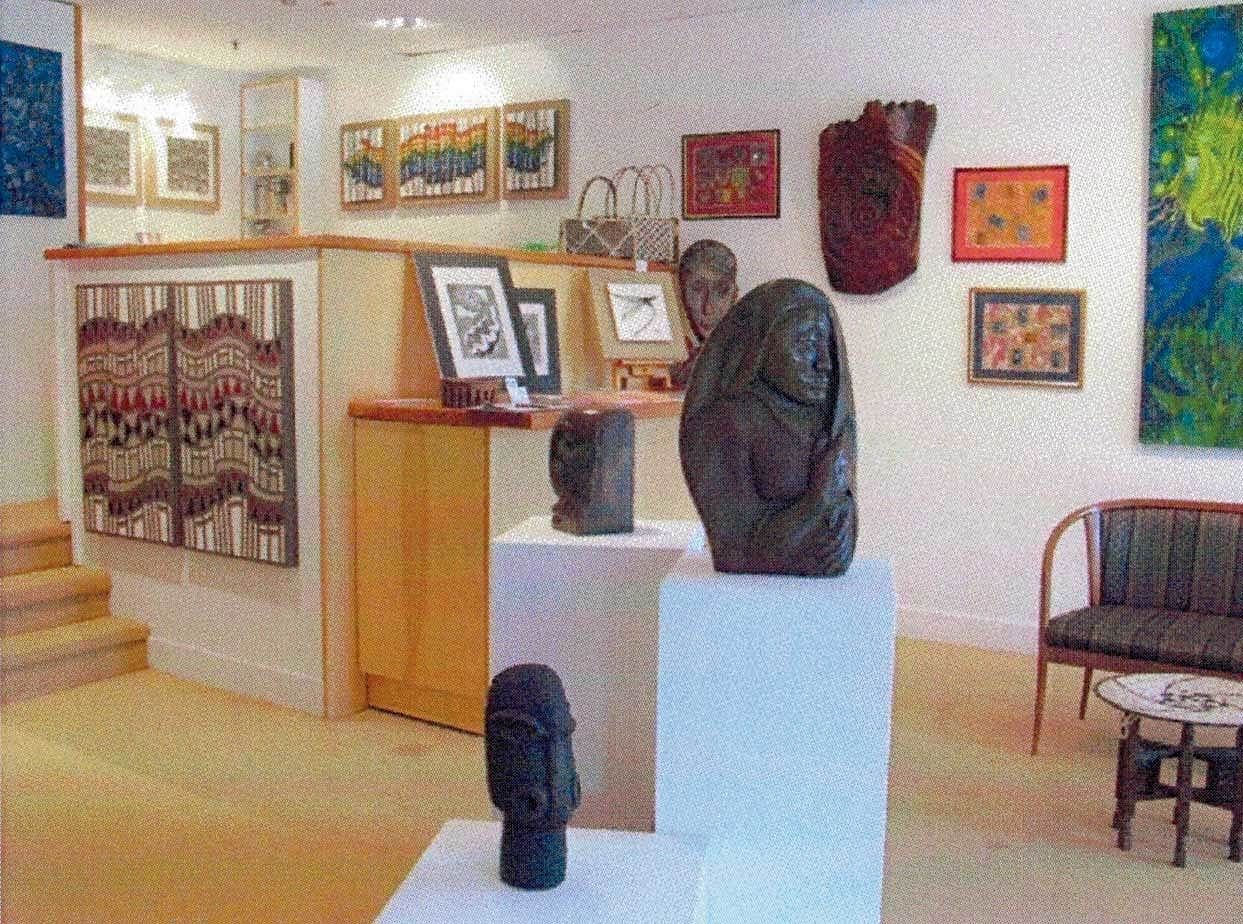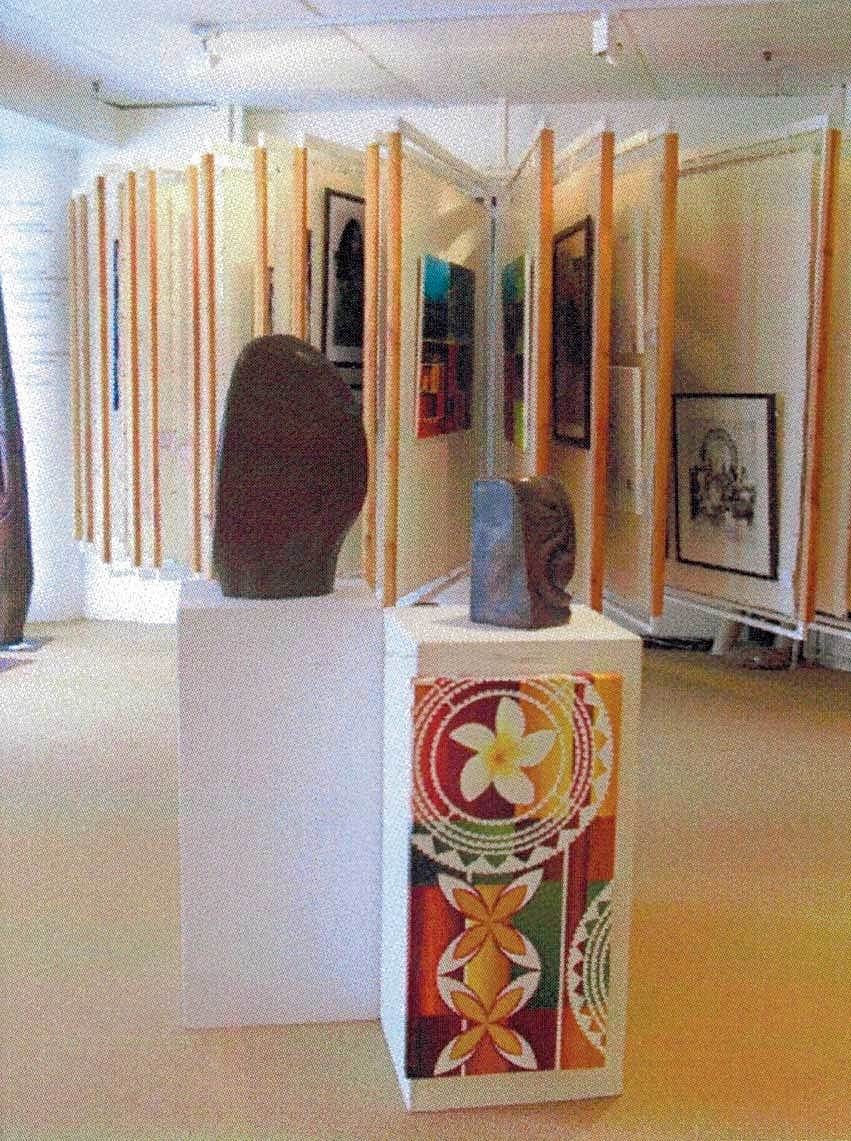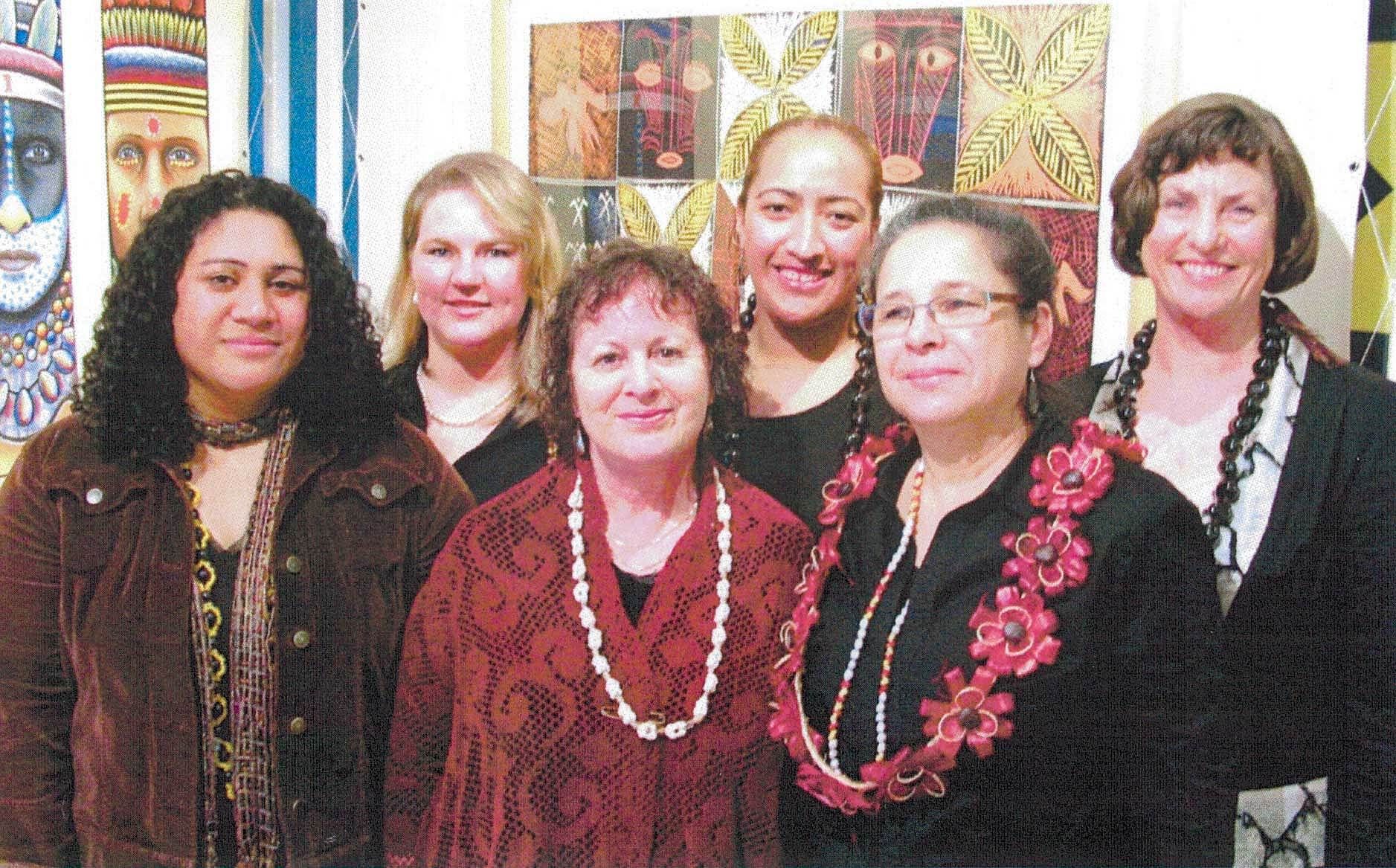The Okaioceanikart Story
Pacific art stalwart Marilyn Kohlhase, or the ‘art lady’ as some people called her, shares the legacy of Okaioceanikart and Okai@Reef Gallery, “the first pan-Pacific art gallery in the world.”
We’re collaborating with Creative New Zealand to bring you the groundbreaking Pacific Arts Legacy Project. Curated by Lana Lopesi as project Editor-in-Chief, it’s a foundational history of Pacific arts in Aotearoa as told from the perspective of the artists who were there.
After my six years as Chair of the now-defunct Creative New Zealand (CNZ) Pacific Arts Committee, Fatu Feuʻu invited me for a coffee to talk about setting up a dealer gallery for Pacific visual artists. Having learnt about the need for artists to get their works into the market, I agreed. After another meeting, Fatu announced his then-wife, Bridget Marsh, wanted to be part of this gallery. Much talk and planning followed and, through the Karangahape Road Business Association’s networking, in February 2007 we opened Okaioceanikart (Okai for short) in the Langham Hotel Mall with Karangahape Road frontage.
Our business model was intended to represent Indigenous Pacific artists who would bring works to sell whenever they wanted. Okaioceanikart combined ideas of kai (food) for the soul, kart (internet shopping), as well as art, ocean and kairos, the Greek concept of time and space. It was neither a shop nor a gallery with white walls; the artworks were hung on purpose-built canvas screens that formed a book that enabled the Okai team to tell stories about the art, the artists and their cultures.
Okaioceanikart
Through connections made via CNZ, in 2007 Daniel Waswas, a well-known Papua New Guinean (PNG) graduate of Elam School of Fine Arts at The University of Auckland, sent us some 25 PNG artists’ works he had brought to a recent residency in Christchurch for Okai to sell. These works attracted significant sales and formed the basis of several Melanesian shows in Wellington – Taim Bilong Melanesia, at Webster’s Gallery; at Pipitea Marae on PNG Independence Day; and at the Pacific Cooperation Foundation (PCF) Melanesia Symposium. Later Te Papa Tongarewa purchased Waswas’s Look within 2 for $19,000, which was a record for a Melanesian artwork at that time.
The historically significant exhibition of contemporary Melanesian art, Spirit of the People (2009), curated by Giles Peterson and shown at the Corban Art Estate, had a wide regional focus that expressed the many complexities of the diasporic communities of Fiji, PNG, New Caledonia, the Solomon Islands and Vanuatu in New Zealand and Australia. Poets Serie Barford, Selina Tusitala Marsh and Doug Poole responded to the works with nine powerful poems.
Our monthly ‘28ths’ (the Okai version of exhibition openings) introduced Pacific curators, artists and their works to buyers and Okai supporters. Speakers ranged from ‘names’ of the art world such as Fatu Feuʻu, Daniel Waswas, the late Jim Vivieaere and Dagmar Dyck, to emerging and mid-career artists – Ellie Faʻamauri, Nathan Suniula, Ahotaʻeʻiloa Toetuʻu, Penny Howard and Cerisse Palalagi – and senior artists, including Sylvia Marsters. Exhibitions would be focused on these artists’ works for the coming month.
A wide regional focus that expressed the many complexities of the diasporic communities of Fiji, PNG, New Caledonia, the Solomon Islands and Vanuatu in New Zealand and Australia
In 2008, with the support of Pacific Island Trade and Invest (PITI), some 28ths became celebrations of National or Independence Days, which promoted not only the art of certain Pacific nations, but also their products, such as coffee, nuts and packaged foods. PITI sponsored me on a buying trip to the Solomon Islands, and we sold all of the few works I obtained. While there was a lack of creative-arts infrastructure, the talent of local artists there was undeniable. In 2013 PITI sponsored Solomon Islands artists Fred Oge and Brian Feni to participate in events in Auckland. Okai sold canvases by both these and other artists to local and international buyers.
Okai’s support for the New Caledonia Siapo Association’s commitment to strengthening ties in the region resulted in us hosting Pasifikana–AK09, with ten visual artists’ works and musicians performing in a large Langham Hotel function room. The works of Alexis Fisiʻipeau, Yvette Bouquet and Paula Gony Boi in the Pasifikana–AK10 exhibition provided an opportunity to experience a lesser-known culture of the Pacific. Powerful political themes reflected that country’s colonial influences. Former Porirua resident Ela Toʻomaga Kaikilekofe’s weaving of her Sāmoan heritage and her husband’s Kanak roots was captured in her stunning copper taulima.
Powerful political themes reflected that country’s colonial influences.
Okaioceanikart
The year 2009 was busy. First up was the celebration of 20 years of Fatu’s life of two loves – Sāmoa and art – with an exhibition and party at the Sinalei Resort in Sāmoa. We had already held a celebration exhibition in November 2008 at the Langham that featured his sculptures, medallions, limited-edition lithographs, canvases and new works.
In June 2009, for The PCF Brother International Pacific Wave Conference: Weathering the Economic Storm, Giles Peterson curated RIP TIDES – CONTEMPORARY PACIFIC ART, in response to the challenges of the global economic recession and the effects those unsettling times were having on the artists, their families and communities, their islands, and the economic and political stability of the region. Thirty artists from ten Pacific Island nations showed works that explored issues of identity, of what it is to speak from the position of different cultures, and the growing divide between rich and poor. I also presented a workshop on creative industries, raising issues of the role of culture and economic growth, climate change and the exploitation of crafts by mass production outside of the region.
The challenges of the global economic recession and the effects those unsettling times were having on the artists, their families and communities, their islands, and the economic and political stability of the region.
Penny Howard’s first major solo show, Atarangi Whenua – Shadowland, a Pacific conversation of ancient remembering presented by Okai at Artstation, Ponsonby, was produced in collaboration with Sāmoan poet Doug Poole. Atarangi Whenua signified Howard’s continuing journey of discovering the bloodlines that link this pale-skinned artist to her Ngā Puhi iwi.
The year 2010 saw Okaioceanikart react to the effects of the global financial crisis. We had held a mini-PNG exhibition at what was then the Reef Café Gallery in Symonds Street. We were fortunate that Phillip McNicholl, owner of the former Reef Shipping company and a significant collector, had previously agreed to host an exhibition of large works on an empty floor in his new premises on Beach Road. Our request to house our works there until we decided where to next led to a new incarnation of Okai@Reef Gallery that lasted until 2013.
Okaioceanikart
Haere Mai I Okai, our inaugural group exhibition, curated by Nina Tonga, captured the essence of Matariki as a time of gathering people together to celebrate and bring forth the introduction of new artists – Reuben Friend, Mason Lee and Nestor Opetaia – to our stable.
Flora Koloa Kapkap, curated by Lisa Taouma in 2010, presented new works by celebrated women artists Dagmar Dyck, Ellie Faʻamauri and Sylvia Marsters. The show attempted to add new dialogue to the tradition of the Polynesian picturesque with big, bright works that were imbued with more than just a happy hibiscus and a sense of the decorative. A CNZ grant funded Lisa as curator and Shigeyuki Kihara as a mentor. The show travelled to the Calder and Lawson Gallery in Hamilton’s WEL Energy Performing Arts Centre.
The show attempted to add new dialogue to the tradition of the Polynesian picturesque with big, bright works that were imbued with more than just a happy hibiscus and a sense of the decorative.
Significant exhibitions in the Beach Road space included Penny Howard’s beautiful Waka Tipuna; okai sons on the reef with David Teata, Abraham Lagi, Daniel Waswas, Laben John Sakale and Kopotama Jacobsen; and Two Samoans from LA, which featured Dan Taulapapa McMullin’s works referencing people in his life with his take on Californian scenes, alongside Chuck Feesago’s intriguing series of Californian siapo.
Alter-Native Surfaces at Aotea Centre, as part of the Pasifika Festival, set out to challenge preconceptions of ‘Pacific art’, and featured four Sāmoan artists – Nathan Suniula, Nestor Opetaia, Sale Pepe and Sekio Fuapopo. Fuapopo, who went to art school in San Francisco in the 1960s, came especially from Los Angeles for Alter-Native Surfaces, which consisted entirely of abstract works. We believe it may have been the first group exhibition of Sāmoan abstract works in the world. Momoe Malietoa von Reiche had held the first solo exhibition of abstract works in Maota Samoa, on Karangahape Road, in the 1980s.
Okaioceanikart
Steve Gwaliasi (body adornment) and David Teata (woodblock prints) won awards at the World Art Market, at the Museum of Anthropology, Vancouver, and sales were made by Chris Delany (on a CNZ travel grant) of works from Fatu Feu‘u, Dagmar Dyck, Ela To‘omaga Kaikilekofe and Sheyne Tuffery.
In 2011, Resilience, our exhibition of 13 artists, was the first Pacific art exhibition at Parliament Buildings, Wellington. The show referenced the 2010 tsunami in Sāmoa, and included a canvas from two National University of Sāmoa students plus a selection of paintings by pupils from Aleipata Primary School, part of an art-therapy project co-ordinated by Leua Latai Leonard.
Bounty Bars and Coconut Roughs, sponsored by Reef Group, was a photographic exhibition in 2012 that also travelled to Parliament Buildings after being part of the Auckland Festival of Photography. The works by four Sāmoan artists, Raymond Sagapolutele, Fofoga Setoga-Tuala, Penitoa Finau and Mau Muaiava, were a tribute to 50 years of Sāmoan Independence. After five decades of lives in New Zealand being captured by family members, a new generation of artists was now recording these same scenes, attracting critical comment with works exhibited nationally and internationally.
This show “challenged the stereotypes and negative connotations that are often cast upon Sāmoan women of how we should and shouldn’t be portrayed in public.”
Okaioceanikart had come to the end of its life in 2012. Jen Fuemana and I started operating as Reef Gallery and ran several more shows, including Mau Muaiava’s Born Savages: Sāmoan Women of Today. As written in the artist's statement, this show “challenged the stereotypes and negative connotations that are often cast upon Sāmoan women of how we should and shouldn’t be portrayed in public.”
Leonard Tebegetu used the space for a residency, in which he created some important works based on rituals related to spirits and ancestors of the New Ireland province of Papua New Guinea, where he grew up. His solo show Ritual Spirit Tradition captured Mud Menand a huge piece, The Advance, of a woman in full dance costume, which was acquired by a Pacific buyer.
Our final event with artists coincided with PCF’s spectacular Pacific Showcase in 2013 at the Cloud on Queen’s Wharf. PITI sponsored the visit of Solomon Islands artists Fred Oge and Brian Feni, who sold works at a number of pop-up shows. In addition, we added tatau artist Cory Weir, Fatu Feu‘u, Sieke Taihia and Sylvia Marsters, plus Sina Panama and her Niuean craft group, who all provided demonstrations of artists at work.
Jen Fuemana, Carrie Bolton, Nina Tonga, Marilyn Kohlhase, Bridget Marsh.
My best memory was being on the phone to Leonard in PNG when a visitor said, “I can’t look any more, these works are really getting to me”, and left. The art of the Pacific had spoken to her.
My final days as the ‘art lady’, as some in the community referred to me, were with Akateretere Arts, which was a vehicle to show and sell some remaining artworks and crafts from Pacific Jewel, which we acquired after the Pacific Showcase. The last showing of artworks was at the Whanganui Arts Trail, in a pop-up gallery sponsored by Masina Maher’s Siapo and Rose, where Tauvela Tamalelagi was artist in residence in her retail arts space. My best memory was being on the phone to Leonard in PNG when a visitor said, “I can’t look any more, these works are really getting to me”, and left. The art of the Pacific had spoken to her.
Hundreds of stories were shared through the artworks of the dozens of artists of Okaioceanikart and Okai@Reef Gallery. We achieved many firsts, not least being the first pan-Pacific art gallery in the world, where some artists from the largest Polynesian nations, as well as Melanesia, first had their artworks exhibited and sold in a gallery space run by Pacific for Pacific.
Fa‘afetai tele lava to everyone, including buyers, who helped Okaioceanikart and Okai@Reef Gallery to support the Pacific artists we were privileged to represent.
Artists represented or included in exhibitions
Melanesia – Fiji, New Caledonia, Papua New Guinea, Solomon Islands, Vanuatu:
Abraham Lagi, Aldio Pita, Alexis Fisiʻipeau, Apa Hugo, Ben Fong, Brian Feni, Bryan Afia, Ralph Ako, Craig Marlow, David Ambong, Elizabet Kauage, Daniel Waswas, Ela To‘omaga Kaikilekofe, Fred Oge, Mara Finau, Frank Maninga Jnr, Jeke Lagi, John To‘o Levi, Joe Nalo, John Bom, Jon Jay, Laben John Sakale, Lambert Ho, Ledua Peni, Paula Gony Boi, Stanley Palmer, Steve Gwaliasi, Tuicake, Letila Mitchell, Mason Lee, Leonard Tebegetu, Lingikoni Vaka‘uta, Riaz Maninga, Yvette Bouquet
Australia, Sāmoa and United States-based:
Chuck Feesago, Dan Taulapapa McMullin, Fofoga Setoga-Tuala, Greg Semu, Kopotama Jacobsen, Lani Tupu, Leua Leonard, Mau Muaiava, Penitoa Finau, Sekio Fuapopo.
New Zealand:
Anna Crawley, Ahota‘e‘loa Toetu‘u, Chris van Doren, Cerisse Palalagi, Cory Weir, Dagmar Dyck, David Teata, Ellie, Fa‘amauri Firisua, Fatu Feu‘u, Filani McCassey, Filipe Tohi, Glenda Vilisoni, Jane Matua, Kulimoe‘anga (Stone) Maka, Leanne Clayton, Matafetu Smith, Merisa Bickerstaff, Mikoyan Vekula, Nathan Suniula, Nestor Opetaia, Penny Howard, Raymond Sagapolutele, Reuben Friend, Sale Pepe, Sheyne Tuffery, Sieke Taihia, Sylvia Marsters, Tauvela Tuala Tamalelagi, Theodore Ah Wong, Tui Hobson, Uili Lousi, Vanessa Wynyard, Zora Feilo-Makapa
Patrons and generous supporters:
Langham Hotel; Karangahape Road Business Association, Barbara Holloway; Pacific Island Trade and Invest, especially Louisa Sifakula and Joe Fuavao; Pacific Cooperation Foundation; Phillip McNicholl and Reef Group team, especially Mele Tiu and Ramsey Tomokino; Mii Pamatatau; Masina Maher, Siapo and Rose; PNG High Commission; Pele Penina Trust
Staff: Jen Fuemana, Carrie Bolton, Nina Tonga, Julia Newall, Kenny Willis. Volunteers and supporters included Sue Smales from Webster’s Gallery, Chris Delany, Helen Schamroth, Candace Weir, Julie Puia, Bonnie Proctor, Fan Yang
Directors: Bridget Marsh and Marilyn Kohlhase
*
This piece is published in collaboration with Creative New Zealand as part of the Pacific Arts Legacy Project, an initiative under Creative New Zealand’s Pacific Arts Strategy. Lana Lopesi is Editor-in-Chief of the project.
Series design by Shaun Naufahu, Alt group.
Header photograph by Tina Engels-Schwarzpaul
